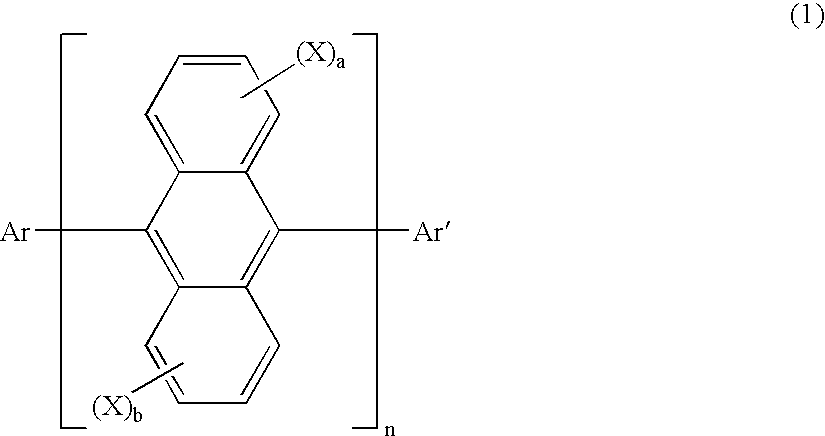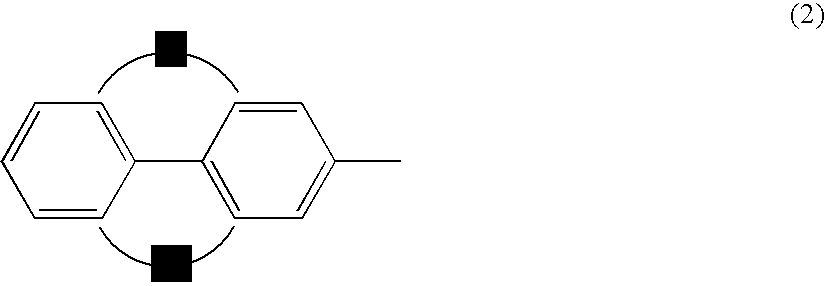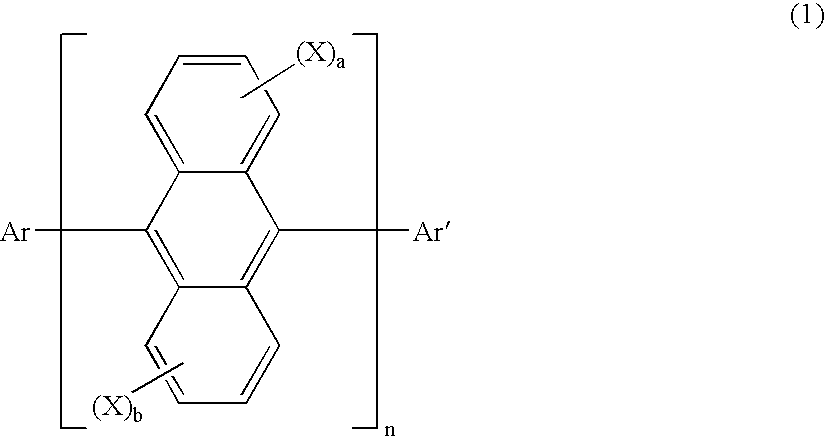Anthracene derivatives and organic electroluminescent devices made by using the same
- Summary
- Abstract
- Description
- Claims
- Application Information
AI Technical Summary
Benefits of technology
Problems solved by technology
Method used
Image
Examples
example 1
Synthesis of a Compound AN1
(1) Synthesis of 4,5,9,10-tetrahydro-2-bromopyrene
[0103] Into an autoclave, 195 g of pyrene (available from HIROSHIMA WAKO Co., Ltd.), 1 liter of decaline (available from HIROSHIMA WAKO Co., Ltd.) and 78 g of 5% palladium carbon (available from HIROSHIMA WAKO Co., Ltd.) were placed, and the reaction was allowed to proceed at 160° C. for 21 hours under a hydrogen pressure of 70 kg / cm2.
[0104] After the reaction was completed, the catalyst was separated by filtration and washed with 3 liters of chloroform. Then, chloroform was removed under a reduced pressured, and the remaining decaline solution was cooled with ice. The formed crystals were separated by filtration, washed with ethanol and dried, thereby obtaining 130 g of crystals.
[0105] The obtained crystals in an amount of 126 g was suspended in 6.3 liters of purified water, and 2 g of ferric chloride monohydrate (available from HIROSHIMA WAKO Co., Ltd.) was added to the suspension. Then, an aqueous so...
example 2
Synthesis of a Compound AN2
[0112] Under the atmosphere of argon, 2 g of 4,5,9,10-tetrahydro-2-bromopyrene obtained in (1) of Example 1 described above was dissolved into a mixed solvent of 8 milliliter of anhydrous THF and 8 milliliter of anhydrous toluene, and the resultant solution was cooled at −20° C. in a dry ice / methanol bath. To the cooled solution, 5 milliliter of a hexane solution of n-butyllithium (1.6 moles / liter; available from HIROSHIMA WAKO Co., Ltd.) was added, and the resultant solution was stirred at −20° C. for 1 hour. Then, 0.8 g of 2-t-butylanthraquinone (available from TOKYO KASEI Co., Ltd.) was added, and the resultant solution was stirred at the room temperature for 4 hours and left standing at the room temperature for 12 hours.
[0113] The reaction mixture was deactivated with a saturated aqueous solution of ammonium chloride, and the formed solid substance was separated by filtration and washed with methanol. The obtained compound was purified in accordance ...
example 3
Synthesis of a Compound AN3
(1) Synthesis of 2,6-diphenyl-9,10-anthraquinone
[0115] Into a 3 liter flask, 130 g of 4-bromophthalic anhydride (available from TOKYO KASEI Co., Ltd.), 243 g of sodium carbonate and 1.3 liters of water were placed, and a solution was prepared by heating up to 60° C. After the prepared solution was cooled to the room temperature, 84.5 g of phenylboric acid (available from TOKYO KASEI Co., Ltd.) and 3.9 g of palladium acetate (available from TOKYO KASEI Co., Ltd.) were added, and the resultant mixture was stirred. Then, the reaction was allowed to proceed at the room temperature for 12 hours.
[0116] After the reaction was completed, the formed crystals were dissolved by adding water and heating. The catalyst was removed by filtration, and crystals were formed by adding concentrated hydrochloric acid. The formed crystals were separated by filtration and washed with water. After extraction with ethyl acetate, the extract was dried with anhydrous magnesium su...
PUM
| Property | Measurement | Unit |
|---|---|---|
| Temperature | aaaaa | aaaaa |
Abstract
Description
Claims
Application Information
 Login to View More
Login to View More - R&D
- Intellectual Property
- Life Sciences
- Materials
- Tech Scout
- Unparalleled Data Quality
- Higher Quality Content
- 60% Fewer Hallucinations
Browse by: Latest US Patents, China's latest patents, Technical Efficacy Thesaurus, Application Domain, Technology Topic, Popular Technical Reports.
© 2025 PatSnap. All rights reserved.Legal|Privacy policy|Modern Slavery Act Transparency Statement|Sitemap|About US| Contact US: help@patsnap.com



